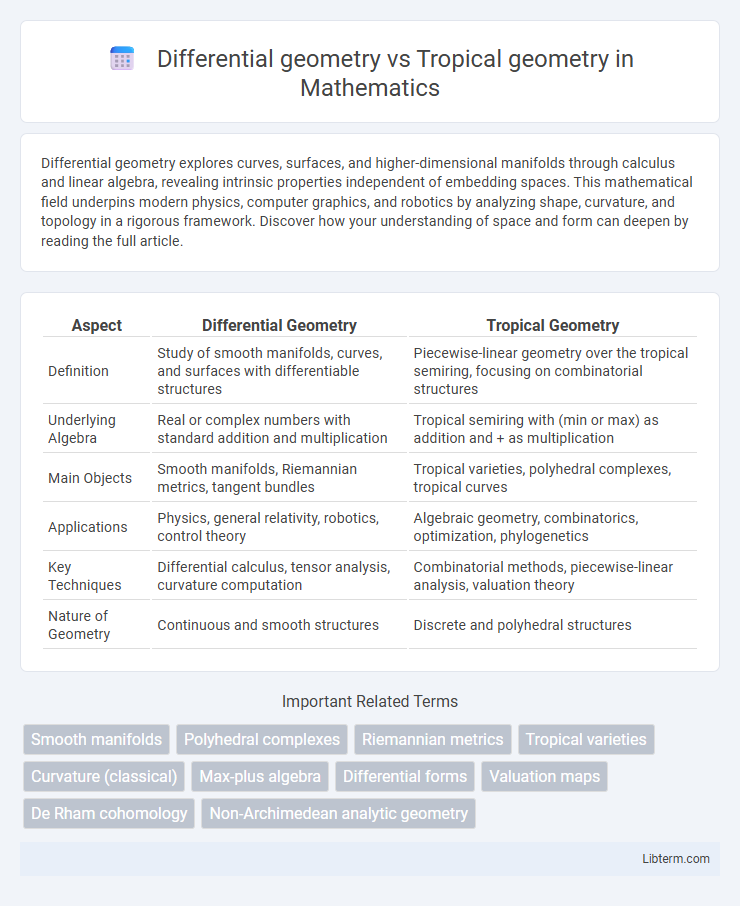Differential geometry explores curves, surfaces, and higher-dimensional manifolds through calculus and linear algebra, revealing intrinsic properties independent of embedding spaces. This mathematical field underpins modern physics, computer graphics, and robotics by analyzing shape, curvature, and topology in a rigorous framework. Discover how your understanding of space and form can deepen by reading the full article.
Table of Comparison
| Aspect | Differential Geometry | Tropical Geometry |
|---|---|---|
| Definition | Study of smooth manifolds, curves, and surfaces with differentiable structures | Piecewise-linear geometry over the tropical semiring, focusing on combinatorial structures |
| Underlying Algebra | Real or complex numbers with standard addition and multiplication | Tropical semiring with (min or max) as addition and + as multiplication |
| Main Objects | Smooth manifolds, Riemannian metrics, tangent bundles | Tropical varieties, polyhedral complexes, tropical curves |
| Applications | Physics, general relativity, robotics, control theory | Algebraic geometry, combinatorics, optimization, phylogenetics |
| Key Techniques | Differential calculus, tensor analysis, curvature computation | Combinatorial methods, piecewise-linear analysis, valuation theory |
| Nature of Geometry | Continuous and smooth structures | Discrete and polyhedral structures |
Introduction to Differential Geometry and Tropical Geometry
Differential geometry studies smooth shapes and structures using calculus and linear algebra, focusing on curvature, manifolds, and geodesics. Tropical geometry is a combinatorial shadow of algebraic geometry, using piecewise-linear structures to analyze algebraic varieties over the tropical semiring. While differential geometry explores continuous and differentiable spaces, tropical geometry provides a simplified, polyhedral perspective on complex algebraic problems.
Historical Development of the Two Fields
Differential geometry, rooted in the 18th century through the works of Gauss and Riemann, developed as a study of curves, surfaces, and manifolds using calculus and linear algebra. Tropical geometry emerged in the late 20th century from algebraic geometry and combinatorics, inspired by idempotent analysis and optimization theory, focusing on piecewise-linear structures and their applications. Both fields evolved independently, with differential geometry grounded in continuous analysis and tropical geometry characterized by its discrete, combinatorial nature, reflecting distinct historical trajectories.
Fundamental Concepts in Differential Geometry
Differential geometry studies smooth shapes and curves using calculus concepts such as manifolds, tangent spaces, and Riemannian metrics, focusing on properties like curvature and geodesics. Fundamental concepts include differentiable manifolds that locally resemble Euclidean space, tangent vectors representing directions of curves, and connections that define how vectors change across the manifold. Tropical geometry, by contrast, operates over piecewise-linear structures and uses combinatorial analogs without relying on smoothness or continuity.
Core Principles of Tropical Geometry
Tropical geometry is a piecewise-linear shadow of algebraic geometry founded on the tropical semiring, where addition is replaced by taking minimum or maximum, and multiplication by addition, enabling combinatorial methods to study algebraic varieties. Core principles include the use of tropical varieties as polyhedral complexes capturing the essential algebraic and geometric features of classical varieties through valuation maps and the tropicalization process. Unlike differential geometry, which relies on smooth manifolds and calculus, tropical geometry operates on combinatorial structures emphasizing piecewise-linear, polyhedral, and graph-theoretic techniques.
Key Differences in Mathematical Structures
Differential geometry studies smooth manifolds using calculus and differential equations, focusing on metrics, curvature, and smooth structures. Tropical geometry operates over the tropical semiring and replaces classical algebraic operations with piecewise-linear counterparts, emphasizing polyhedral complexes and combinatorial structures. The key difference lies in differential geometry's reliance on smoothness and curvature versus tropical geometry's discrete, combinatorial, and piecewise-linear framework.
Major Applications and Real-World Impacts
Differential geometry plays a crucial role in physics, particularly in general relativity, where it models the curvature of spacetime and gravitational fields, and in robotics for motion planning and control. Tropical geometry, a piecewise-linear version of algebraic geometry, finds applications in combinatorics, optimization, and computational biology, especially in phylogenetics and network analysis. Both fields contribute to data science by enhancing algorithms for handling complex geometrical structures and optimizing nonlinear problems.
Techniques and Tools Used in Each Geometry
Differential geometry employs calculus, smooth manifolds, and tensor analysis to study curves, surfaces, and their properties through metrics and curvature. Tropical geometry utilizes combinatorial structures, piecewise-linear functions, and polyhedral complexes to analyze algebraic varieties in a piecewise-linear setting. The techniques in differential geometry rely on continuous transformations, while tropical geometry leverages discrete, combinatorial methods to simplify complex algebraic problems.
Modern Research Trends and Open Problems
Modern research trends in differential geometry emphasize the study of geometric flows, complex manifolds, and the application of curvature-based invariants in understanding the topology of high-dimensional spaces. Tropical geometry explores combinatorial structures and piecewise-linear objects, using tropical varieties to approach classical problems in algebraic geometry and mirror symmetry. Open problems intersecting both fields include characterizing tropical analogs of classical differential invariants and developing unified frameworks to translate curvature and metric properties into the tropical setting.
Intersections and Interactions Between the Fields
Differential geometry and tropical geometry intersect through the examination of geometric structures and their behaviors under different mathematical frameworks, with differential geometry focusing on smooth manifolds and curvature while tropical geometry studies piecewise-linear structures arising from algebraic varieties. The interaction is evident in tropicalizations of complex algebraic varieties, where tropical geometry provides combinatorial shadows of differential-geometric objects, enabling new computational approaches to intersection theory. This synergy advances understandings in enumerative geometry, with tropical intersections offering discrete models that reflect the continuous properties studied in differential geometry.
Future Directions in Differential and Tropical Geometry
Future directions in differential geometry emphasize the integration of machine learning techniques to analyze complex geometric structures and the development of geometric flows to solve longstanding problems in topology and physics. Tropical geometry research focuses on expanding its applications in algebraic geometry, particularly in moduli spaces and mirror symmetry, and enhancing computational methods to handle large-scale combinatorial data. Both fields are converging towards interdisciplinary frameworks that blend combinatorial, analytic, and algebraic approaches to address problems in mathematical physics and optimization.
Differential geometry Infographic

 libterm.com
libterm.com